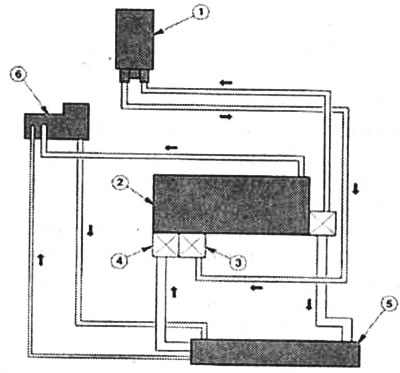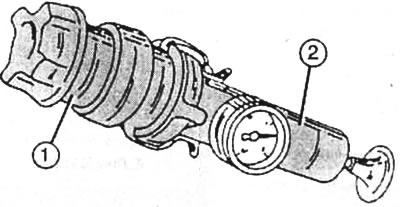Under normal operating conditions, the Focus cooling system is constantly in a healthy temperature range. Cooling is a system consisting of a number of units: radiator, water pump, radiator fan, thermostat, expansion tank, coolant pipes and hoses are the elements of the plan - the coolant does its direct work in the engine block and cylinder head in a filigree network of water channels with exact proportions, in the so-called water jacket. The excess heat of combustion, accumulated first in the water jacket, is then discharged through the radiator into the atmosphere. Which way the coolant circulates is highly dependent on engine temperature.

Schematic representation of the engine cooling system: 1 - heat exchanger - heating; 2 - engine, 3 - thermostat; 4 - water pump; 5 - radiator fan; 6 - expansion tank with coolant.
Cold engine - small coolant circuit
After each start of a cold engine, the coolant circulates first through a small circuit, which is limited by a water jacket and heating. During this phase, the thermostat closes the path to the radiator until the engine reaches operating temperature.
There is a significant reason for this, since there is less coolant in the small circuit - the engine reaches the desired temperature faster and emits less exhaust gases. Only when the coolant reaches its operating temperature does the thermostat open and meteredly passes hot coolant from top to bottom through the radiator. On the way through the heat exchanger, the headwind passing by the radiator fins blows over the hot coolant and takes away excess engine heat from it.
The thermostat-coordinated interaction of water and air protects the engine equally from both cold shock and thermal shock.
Warm engine - large coolant circuit
At normal operating temperature, coolant will circulate in the Focus to the water pump from the coolant box on the right in the direction of travel. From there, it enters the engine block and cylinder head: the vast majority of the liquid returns through the open thermostat to the left coolant box, while the rest passes through the heating heat exchanger. Fluid flowing down in the radiator makes room for hot fluid at the top. When passing through the radiator plates, it cools again, the circuit is closed. If the coolant temperature falls below the prescribed operating temperature during a trip, the thermostat closes until the coolant has warmed up again.
The cooling system is under pressure
The cooling system when the engine is running is under a certain overpressure. This raises the boiling point of the coolant from 100°C to approximately 120°C. The increased temperature results in a more economical operation of the engine and, consequently, reduced fuel consumption. If the coolant pressure, depending on the engine version, exceeds 0.85-1.2 bar when the engine is hot, the overpressure valve in the expansion tank sealing cap opens and vents the excess system pressure to the atmosphere. The vacuum that occurs when the coolant cools down is equalized by the second, so-called vacuum valve in the locking cap - it passes atmospheric air into the tank. Often, the oncoming air flow is not enough, especially when driving in a city or in traffic jams, in order to protect the engine from damage due to overheating. For this case, all Focus models have a radiator fan directly behind the radiator (Zetec-E, dual fan) with electric drive. This small wind farm is activated by a thermal switch at around 120°C. The fan switches off again automatically when the normal operating temperature is reached.

Pressurized: The cooling system is checked with a mechanical pump 1. To do this, a pressure of approx. 1.6 bar is created in the radiator or in the expansion tank for approximately 5 minutes. The pressure in the system must drop by about 0.2 bar, otherwise find and fix the leak; 2 - locking cap of the expansion tank.
Engine temperature is constantly monitored
In the event that under extremely high load, such as when driving with a trailer, or due to some kind of malfunction, the engine temperature is constantly excessively high, the Focus has an overheat program to protect against major engine damage, stored in the memory of the transmission control unit (RSM). In step 1, the program sets the pointer of the temperature indicator in the red range of the indicator device. If this signal is ignored and the temperature continues to rise, a warning light on the instrument panel lights up «Transmission». In this case, you must definitely turn off the engine, let it cool down and then drive to the Ford workshop. During this time, the control unit did not remain inactive, it stored a fault code in memory, which Ford workshops read with the FDS2000 diagnostic tool.
But if you consistently ignore or just don't notice the warning light and the temperature indicator, stage 2 of the program comes into play: the PCM shuts down two cylinders and limits the engine speed to 3000 rpm. At the same time, the warning light comes on - engine control system (MIL) - it warns in time about possible damage to the engine. In order to cool the engine more efficiently, the deactivated cylinders suck in clean air at this time. cylinders «are paralyzed» in order to achieve uniform cooling of all cylinders. If you are not impressed by all this, stage 3 begins to operate: signal light «Transmission» starts flashing to show you that you have exactly 30 seconds to pull the Focus to the side of the road as the engine is fully deactivated to prevent further damage or seizure.
Visitor comments